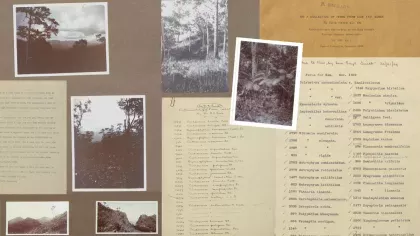13 October 2017
‘Infinitely more curious than handsome’: Joseph Dalton Hooker and the Pyramids
Cam Sharp Jones explores some of the illustrative works produced by Joseph Dalton Hooker held in Kew’s art and archive collections, particularly those from a visit that Hooker undertook to see the Pyramids in Egypt.

Joseph Dalton Hooker - artist
In addition to housing thousands of Joseph Dalton Hooker’s letters, the Library, Art and Archives department at Kew contains numerous illustrations and sketches completed by Hooker during his travels.
These visual documents provide invaluable information on how Hooker worked, collected and viewed the world in which he was moving. Hooker was taught from an early age to draw and document the world around him, writing “the great advantage of drawing is that it teaches accuracy – or ought to do so” (Huxley, Life and Letters, vol. 2, p. 368)
In many cases these illustrations are related to his botanical pursuits but there are also those which reflect his wider interests in ethnography, topography and geology. They also provide evidence of Hooker as a traveller and tourist. One such example can be seen in Joseph’s visit to Cairo which he recorded both textually and visually.
Joseph Hooker and the Pyramids
In 1847, Joseph Dalton Hooker was, as so often was the case, on the move. Having tested his mettle against the inclement seas and shores of the Antarctic, Hooker had this time set his sights on India and its botanical treasure-troves.
Landing in Calcutta in January 1848, Hooker's journey had started the previous November when he boarded the H.M.S Sidon at Portsmouth. Hooker travelled via Lisbon, Gibraltar, Alexandria, Cairo and Aden as he made his way east.
Whilst botany was a focal point during his travels, he also played the part of the tourist - visiting various notable sites along his route. One of these was the Pyramids at Giza.
In a letter dated 17th November 1847 to his father, Hooker writes that “the first view of Cairo is very good, especially at sunset, when the sinking sun darted forth golden beams along the desert, lighting up the Pyramids, which appear in strong relief & gilding the white hill that overtops Cairo” (JDH/1/10 f.3-4). However Hooker’s attention appears to have been quickly diverted from this wondrous sight back to natural history – “To me, however, the banded cliffs of Sand along the banks, were very suggestive: indicating as they do, the successive deposits of fertile soil…” (JDH/1/10 f.14-17)
In a more extensive letter to his aunt, Lady Elizabeth Palgrave, Hooker writes “We beheld the Pyramids, 6 miles off, in a straight line; they rose above the Palm-trees & looked grand in the distance; although different from anything that can be seen elsewhere. But they are so infinitely more curious than handsome, that it is impossible to help feeling that in many other shapes, they would have looked bigger, & in any other more attractive. In themselves they do not invite, as most remarkable objects would do, a closer inspection; it is the force of Associations which compels you to approach, together with your previously acquired information respecting the empty wonders they enclose.” (JDH/1/10 f.14-17)
Hooker does not seem to have been that impressed by the Pyramids or the Sphinx for their artistic merit, continuing to his aunt that “Of merit of execution, it [the Sphinx] has none: - grandeur, beauty, placidity & dignity are alike wanting, there is not a worse or more ineffectual piece of workmanship in St Paul’s or Westminster Abbey. Like the Pyramids, it is wonderful, & suggestive to an educated individual; - but nothing more.” (JDH/1/10 f.14-17)

The view from the top
The indifference voiced by Hooker to his aunt did not however stop Hooker from climbing to the top of the Great Pyramid, stating that although “the view from the summit is magnificent”, he “made a few sketches of these scenes, the grandest perhaps, but certainly the least attractive, I had ever viewed” (JDH/1/10 f.14-17). Nor did it stop him from entering the interior of the Great Pyramid - “the inside of the Pyramid was to me incomparably more striking than the exterior…” (JDH/1/10 f.14-17). In his letters he describes the polished granite and sarcophagus of the Kings Chamber. Hooker also sketched the arrangement of the pyramids as well as side views of the interior of the Great Pyramid, and as a thorough observer and tireless documenter he recorded measurements of the interior of the Kings Chamber in his travel notebook.
Perhaps not surprisingly even such touristic pursuits gave Hooker a chance to botanise – whilst standing at the top of the Great Pyramid, surveying the expansive view before him, Hooker recollects that he gathered “all the Lichens I could find on the stones near the summit (where alone they grow)” (JDH/1/10 f.14-17)
2017 is the bicentenary of Joseph Hookers birth and the Joseph Hooker Correspondence Project is exploring the life and work of this influential figure. Images and transcripts of letters sent by Hooker such as those mentioned in this blog, can be found on the Joseph Hooker Correspondence Project webpages along with more details of his life and career. To view more of Joseph Hooker’s illustrations held by Kew, please contact the Library, Art & Archives department.
Further reading
Desmond, Ray, Sir Joseph Dalton Hooker, travellers and plant collector, Antique Collectors Club: Woodbridge, 1999, p.96
Hooker, Joseph Dalton, Notes of a Tour in the plains of India, the Himala, and Borneo; being extracts from the private letters of Dr Hooker, written during a government botanical mission to those countries, part 1 England to Calcutta, Reeve, Benham and Reeve: London, 1848
Huxley, Leonard, Life and Letters of Sir Joseph Dalton Hooker, John Murray; London, 1918


